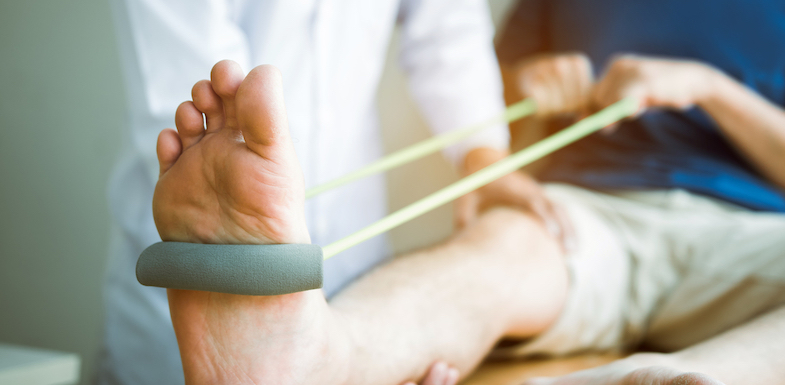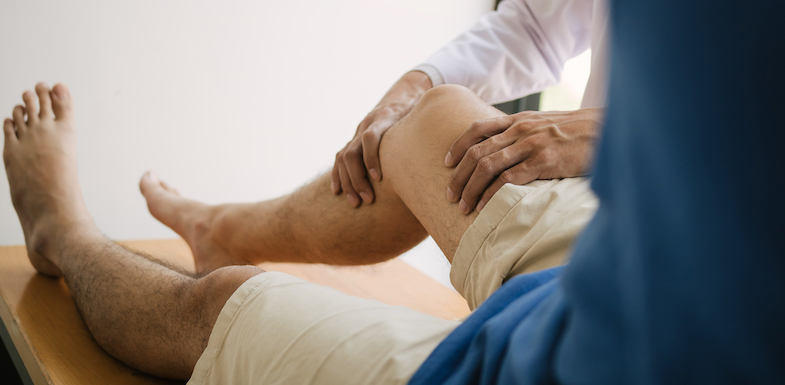Knee pain affects one-third of people in the U.S. every year. It’s the second most common cause of chronic pain! Unfortunately, it makes sense. This weight-bearing joint is crucial to helping us move about our daily lives. Whether you are looking to explore long-distance hiking or just run a few errands pain-free, here’s how seeing a chiropractor for knee pain can help.
How does chiropractic care for knee pain work?
Chiropractic care may have a reputation for cracking backs and popping necks and shoulders, but it goes well beyond that stereotype. Yes, the focus of chiropractic care is on alignment, but it’s specifically interested in both alignment and function. Chiropractic techniques for knee pain focus on the health of the joint itself, ensuring proper function.
This is important because your knee is a complex joint.
The knee joins four bones: the femur, the tibia, the fibula, and the patella. Supporting those bones are the quadriceps in the front of the knee and the hamstrings in the back. Ligaments and cartilage form an intricate network of connections that help stabilize the knee. These include the:
- Anterior cruciate ligament (ACL): Prevents the femur from moving backwards onto the tibia
- Posterior cruciate ligament (PCL): Prevents the femur from sliding forwards
- Medial and lateral collateral ligaments: Provides support inside and outside of the knee
The meniscus (lateral and medial) is tissue that provides ease of movement between the femur and the tibia. Another type of cartilage provides the same function behind the patella. Cushioning all of this are bursae, fluid-filled sacs that help with comfortable movement.
Chiropractors have over 150 techniques they can use to bring your joints back into alignment. Seeing a chiropractor for knee pain can address many of the issues we’ll discuss below.
More than that, chiropractors are looking at whole-body wellness. The knee may be where you feel pain, but that pain may just be a symptom of another issue in your body. The goal of chiropractic for knee pain is to not only help with the pain but to also heal the entire body.
What types of knee pain could benefit from chiropractic care?
Due to this complexity and the role they play in movement, our knees are vulnerable to injury and deterioration due to many wear-and-tear conditions. Some common causes of knee pain include:
- Dislocated kneecap
- Knee bursitis
- Osteoarthritis
- Patellofemoral pain syndrome (runner’s knee)
- IT band syndrome
- Gout
- Loose or injured tissue or bone
- Tendinitis and tendinosis
- Torn meniscus
- Torn ACL
- Rheumatoid arthritis
- Overuse (as occurs during long hikes or bike rides)
There are several types of knee pain that respond well to chiropractic care—and a few that don’t. Let’s look at these in more detail.
Osteoarthritis
Osteoarthritis is a wear-and-tear condition that affects the ligaments, tendons, and cartilage of the knee. Over time, these structures begin to wear out, causing painful bone-on-bone contact. This wear can be increased by poor gait or inadequate footwear. If you are experiencing this type of knee pain, chiropractic care can help to stabilize and align the joint while increasing your range of motion for more comfort.
Research has shown that manual knee therapy helped significantly decrease knee pain while improving mobility.
Runner’s knee
You don’t need to be a runner to suffer from runner’s knee! This condition (also called patellofemoral pain syndrome) occurs when the bones in the knee aren’t lining up properly. This causes pain in the kneecap and a popping or clicking sound when you move.
Misalignment anywhere from the hips to the ankles can cause the knees to be misaligned, so it can be a good type of pain to treat with chiropractic care.
Tears to ligaments and tissues
Since chiropractic care for knee pain does not just focus on the pain symptom alone, tears to ligaments and tissues in the knee often benefit from it.
While research on specific types of tears and strains is limited, many chiropractic patients report they are able to avoid more invasive surgery to treat these conditions or refer patients to the appropriate specialist.
Referred pain
In some cases, knee pain does not actually originate in your knee. Pain that is caused elsewhere in the body is called “referred pain.”
The most common type of referred pain is either caused by compression of the sciatic nerve in your lower back or by injury or damage in the sacroiliac joint. Even injuries to the cervical spine can cause pain in the knees.
Chiropractic care for knee pain that is referred can help resolve not only that pain but also pain elsewhere in the body.
What conditions should not be treated with chiropractic care?
It’s important to note that chiropractic care for knee pain is not recommended when your pain is inflammatory in nature.
For example, rheumatoid arthritis, psoriatic arthritis, ankylosing spondylitis, and an active flare-up of knee inflammation should not be treated with chiropractic techniques. Talk to your chiropractor about the best specialist in these cases.
What does a chiropractor for knee pain do?
Chiropractors are interested in locating where the structure of the body is off and causing pain in its function.
Below are some of the basic services they provide in their office, plus an overview of chiropractic exercises for knee pain that you can do at home.
Chiropractic techniques for knee pain
As chiropractors look at the whole body, some of the chiropractic techniques for knee pain may start far away from the knee.
They may start with the spine, making sure you are aligned using different types of chiropractic adjustments. The most common type, direct thrust, is also the most well-known. This technique is what gives chiropractic its “back-cracking” reputation. While this technique is not appropriate for knees, it can be a good place to start for referred pain conditions.
Instead, more specific chiropractic joint adjustments include:
- Articulatory: A slow movement through the joint’s range of motion
- Myofascial release: Pressure applied to stiff areas and then released to help free up tightness
- Functional technique: When the joint reaches the end of its range of motion, gentle pressure is applied until it releases
Your treatment will be customized to your specific type of pain and what your chiropractor finds during your initial consultation.
Chiropractic exercises for knee pain
Chiropractic exercises for knee pain focus on strengthening the muscles above and below the knee while working to increase range of motion.
They might include:
- Full or half squats
- Calf raises
- Seated quadriceps lift, with or without weight
- Heel and calf stretches
- Side leg raises (with or without a resistance band)
Your pain and underlying condition are as unique as you are. Always work with your doctor or chiropractor before attempting any of these exercises. They’ll help determine which will best support your healing.

Beyond chiropractic
Chiropractic techniques for knee pain go beyond the adjustments and treatments described above.
Many chiropractors will also work with you to design a comprehensive treatment plan that includes nutritional guidance and supplementation that supports total body wellness. They can also refer you to other specialists for care.
What can I expect during my chiropractor appointment?
Your first session with your chiropractor will most likely be your longest. During this visit, your chiropractor will take a detailed medical history. This will include not only your current pain condition but also any previous injuries or health issues.
After giving your medical history, it’s time for your chiropractic exam. Your doctor will move your knee through its range of motion, checking for muscle strength, tone, and response. They will consult any imaging or other test results as well. You may also have other testing, such as a posture or gait analysis, before treatment begins.
The medical history, chiropractic exam, and additional evaluations are all used to design your treatment plan. This treatment plan details which adjustments you will receive, how often, and what other complementary treatments your chiropractor recommends.
You will then receive treatment. Most treatments will be conducted fully clothed. Wear loose pants to allow access to the knee. Your first visit may be an hour or more, but each subsequent treatment will be much shorter.
How many treatments will I have?
Depending on the condition, you may visit the chiropractor between one to three times a week in the acute phase, gradually tapering off as your body begins to realign and symptoms improve.
Many patients begin to see positive effects of chiropractic for knee pain after one to four weeks of treatment.
Recovery time
The recovery time after treatment is usually minimal. The majority of patients continue about their day with no stopping.
If you are new to chiropractic care, it makes sense to take it easy after treatment. Swap the intense workout for a more modest pace, and make sure to stay hydrated and eat healthy food to support overall wellness.
Side effects
There are very few side effects or risks of chiropractic care for knee pain. General soreness is most common.
Exceedingly rare but serious side effects can include worsening symptoms and a specific type of stroke (associated with cervical neck adjustments). Patients at risk of stroke, those with cancer of the spine, and anyone experiencing numbness, tingling, or reduced arm and length strength should not receive chiropractic care for knee pain.
Will it hurt?
Most chiropractic adjustments are completely pain-free. Some patients may feel tense, though, or may tense up during treatment. This may cause some discomfort in the beginning.
Your chiropractor can help you to relax with breathing techniques. It also helps if you understand what will be happening before it happens. For some, the unknown is what causes tension. Education can help! Ask your chiropractor any questions you have.
Other knee pain treatments
There are a variety of other knee pain treatments that can be helpful. Many of these are offered in conjunction with chiropractic care.
- Ice: One of the lowest-tech treatments, this standby helps with inflammation and pain
- Physical therapy: Physical therapy includes range-of-motion and strengthening exercises
- Braces: A knee brace provides additional support while treatment progresses
- New shoes and gait analysis: If your shoes aren’t supportive and your balance is off, new shoes for knee pain and a gait analysis can help
- TENS therapy: This therapy replaces pain with a mild buzzing sensation that can make it possible to proceed with other treatments (especially good for knee pain at night)
- Injections: A variety of knee pain injections are available to reduce pain and inflammation, especially during the initial rounds of therapy
- Nerve blocks: These may be necessary when a person has pain after knee replacement or if they suffer from severe osteoarthritis
- Spinal cord and peripheral nerve stimulation: These two treatments are more invasive than TENS therapy but can provide long-lasting relief for chronic, severe pain
Knee surgery is only indicated in serious cases when other conservative treatments have failed (or the injury must be repaired before rehabilitation).
Arizona Pain has many different ways to manage your knee pain. Our goal is to help you live a full life with less pain. If you are interested in exploring chiropractic care for knee pain (or have questions about our other treatment options), get in touch today.
